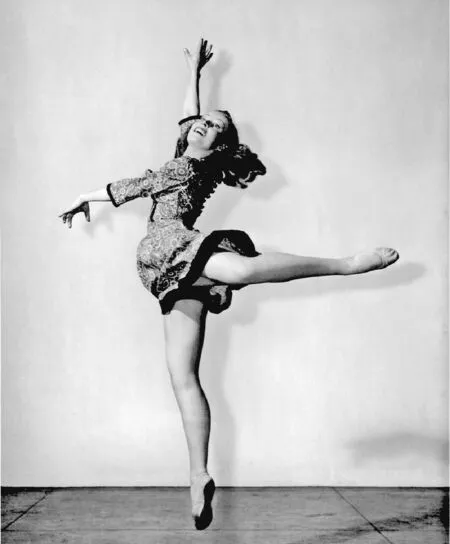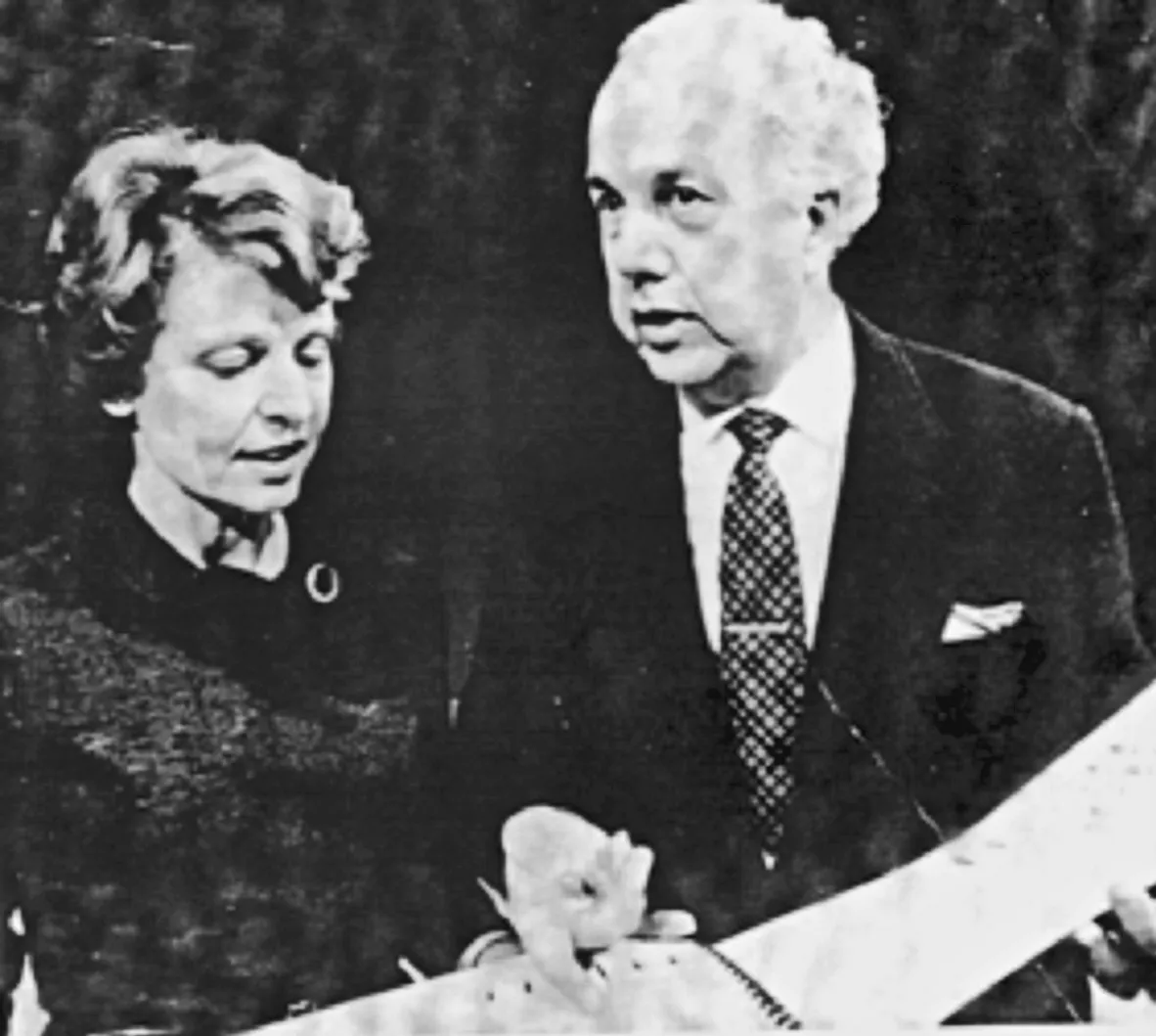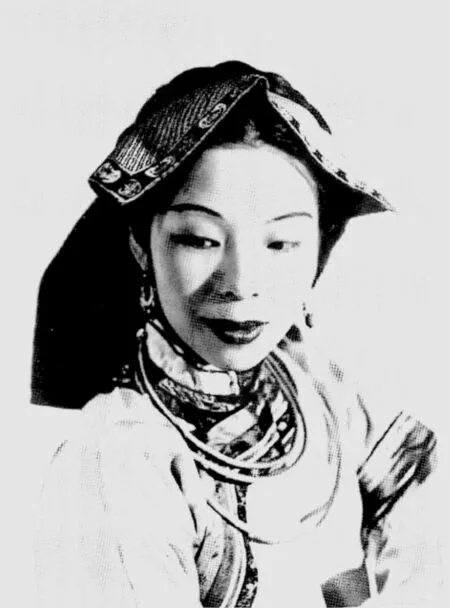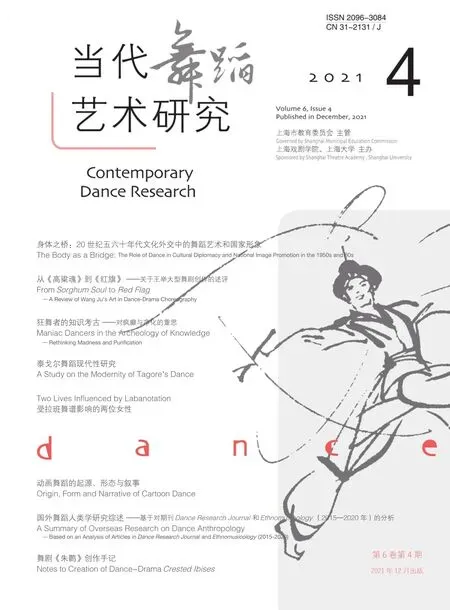Two Lives Influenced by Labanotation
[USA] Ann Hutchinson Guest
The movement notation system,originated by Rudolf Laban,made a marked effect on the lives of two women—one American and one Chinese.
Fate played a part in the case of Ann Hutchinson.My father was from Philadelphia and my mother was from Boston,but I was born in New York City where I spent my early childhood.When I was seven,my brother became ill and needed a milder climate.Because my stepmother was English,my family decided to move to the United Kingdom and send my brother to a boarding school where he would get special health attention.My love for dance was not revealed in my childhood.When I was eight years old,I had a burst appendix,and the doctor gave me five hours to live.As the medical profession and rehabilitation care was not like today,I was confined to bed for a month and had to learn to walk again.Another operation followed,so I could not run,jump or swim for two years.To cure my clumsy walking,the doctor advised my parents to give me dance lessons.From day one,I knew this was what I wanted to do (Picture 1); thus,my illness proved to be a blessing in disguise,so I believe very much in fate.From the very beginning,I found myself gifted in improvisation.On my sixteenth birthday I told my parents that I wanted to be a dancer.They would have sent me to a ballet school in London,but at a dinner a Danish friend who had been there said,“If you know anyone who is interested in dancing,there is a wonderful school at Dartington Hall,in Devon.There is a Baronial Hall,an outdoor theatre,a lovely estate.” As this sounded better than a school in London,I was sent to the Jooss-Leeder Dance School,which offered a Laban-based European modern dance style.My parents did not know the difference between ballet and modern dance,so I took the three-year course at the Jooss-Leeder School.The curriculum included notation sessions twice a week on what was then called “Script”.I found it interesting,enjoyed the logic of the system and became very good at it.After I graduated,Kurt Jooss asked me to stay for a year to notate his ballets,starting with the famous The Green Table (Picture 2).This task gave me a wonderful experience as a dance notator.If I had gone to the ballet school in London,I would never have been involved in Laban’s dance notation (Labanotation) and my dance life would have been very different.

Picture 1:Ann Hutchinson performing as a student.

Picture 2:Ann Hutchinson discussing The Green Table score with Kurt Jooss.
At the same time,Trinidad-born Tai Ai-lien (later known as Dai Ailian) was studying classical ballet in London with distinguished Russian teachers.With her Chinese face and short,rounded body,she came to realize that she would never get into a ballet company in England.On seeing a performance of Ballets Jooss,she went backstage to speak with Kurt Jooss and expressed her interest in joining his company.Kurt Jooss offered her a scholarship to his school instead.Thus,she came to the Jooss-Leeder School during my second year,and we were acquainted and indeed became good friends.Ailian also developed an interest in notation.When the Second World War broke out in 1939,she made her decision to go to China.She was the first person to introduce the Laban system,now called Labanotation,to the Chinese dance world.After I returned to New York at the end of 1939,the two of us lost touch for the duration of the war.
In China,Ailian became aware of the many regional folk dances and the importance of these dances in the Chinese culture.She notated Eight Chinese Nationalities Folk Dances,Eight Yi Folk Dances and Eight Tibetan Folk Dances among others (Picture 3).Later on,her advanced Labanotation students picked up on this task and contributed many more.

Picture 3:Ailian Dai in Peng Song’s choreography inspired by a traditional dance of the Jia Rong people.
When I arrived in New York on December 30,1939,the musician John Colman,who knew me from Dartington,asked Hanya Holm to invite me to teach Labanotation at her school,since Holm’s former in-house notation teacher,Irma Otte Betz,had recently died.Irma Betz had studied notation with Rudolf Laban during his brief visit to the United States in 1936.She then continued to study with him through correspondence.When working with two of Betz’s senior students,Eve Gentry and Janey Price,I discovered differences in the way they and I had been taught.Helen Priest,who had studied Kinetography Laban with Albrecht Knust in Germany,joined our discussions and revealed additional differences.At a meeting with Hanya Holm and theNew York Timesdance critic John Martin,Albrecht Knust suggested we four girls formed an organization to clarify and spread the use of Labanotation.The Dance Notation Bureau (DNB) was established in May 1940.Although I was the youngest among the four,I was the most experienced in notating and using the system.
At the 1940 Bennington Summer Course I discovered Martha Graham’s modern dance technique and decided I must study it.While other modern dancers in the States looked down on European modern dance,Martha reassured me that my Laban background would serve as a good foundation for any dance form I wished to follow.Before long,I discovered I needed to study ballet to get a dance job.I had not seen a ballet performance until I was 19.Most little girls are introduced to ballet at the age of 5.While many modern dance lovers scoffed at ballet,I found myself loving it.Gradually,I started to learn other dance forms to get a broader dance education.As a result,I was versatile and became successful in auditioning for Broadway musicals.I danced in one show after another for eight years.During this period,I continued my notation work with other colleagues and was in charge of the DNB.I then taught at the newly established High School for the Performing Arts,and then at the world-renowned Juilliard School of Music when Martha Hill established a Dance Department in 1951.In 1948,John Colman introduced me to George Balanchine,the famous choreographer.He tested my notation skills in a pas de deux rehearsal.Satisfied,he came to my apartment to study the system and,after a few sessions,he clearly understood how it worked.He then commissioned the DNB to notate a series of his ballets (Picture 4).As many of his repertories were already known by his company dancers,I called in colleagues to help interview the dancers to record what each one did.From 1948 to 1961,I notated 10 Balanchine scores either alone or with assistance from other notators,the first beingSymphony in C.Others wereBourrée Fantasque,Concerto Barocco,Symphony Concertante,The Four Temperaments,Serenade,Agon,and so on.When possible,I notated while Balanchine was creating his new work andOrpheusbeing the first of these.In the subsequent years,until 1990,additional Balanchine scores were notated by the DNB notators.In 1983,American Ballet Theater (ABT) would not have been able to revive Balanchine’sSymphony Concertanteif the DNB Librarian,Patricia Rader,had not told Michael Lland,the ABT ballet master,the existence of this particular Labanotation score at the DNB Library.This ballet had already disappeared from the Balanchine repertoire,and no one remembered enough to stage it.My score at the DNB Library proved to be a valuable source to bring the dance back to life.

Picture 4:Ann Hutchinson notating during a Balanchine rehearsal,1949.
If there is one proudest moment for me in my notation career,it must be when I deciphered Vaslav Nijinsky’s notation system.The famous dancer,Vaslav Nijinsky,learned the Stepanov system when he was a student at the St.Petersburg Dance Academy.He retained his interest in notation while under house arrest in Hungary during World War I.He developed his own notation system and recorded his ballet,L’Après midi d’un Faun.After Nijinsky’s death,his widow,Romola,gave the notation score to the British Library,but no one could read it.Romola wanted to recover the piece from the notation and approached me.She gave me unrelated materials.She then met my colleague,Claudia Jeschke,and enlisted her as well.We decided to work together to decipher Nijinsky’s notation and we successfully translated it into Labanotation.In 1988,I taught it to a group of dancers at the Royal Ballet School in London.It was a wonderful feeling to see Nijinsky’s work unfold and be performed before my eyes.This popular ballet had been kept alive through many memory-based versions,several quite distorted.In 1989,Claudia and I started teaching the only authentic version to Les Grands Ballets Canadiens in Montreal,Canada.The Labanotation bookNijinsky’s Faune Restoredwas published in 1991.Subsequently,many dance departments in the U.S.wanted to perform the work as part of their study of the historical,stylistic and choreographic content.Monica Mason,director of the Royal Ballet in London,believed this to be the “correct” version and it was performed by the Royal Ballet in 2000 and 2004.
In China,Ailian’s knowledge and ability in ballet led her to be named the principal of the Beijing Dance School (now Beijing Dance Academy) and later Director of the National Ballet of China (Picture 5).Around 1977—1980,Ailian,in rehearsing the ballet classics at the National Ballet,contacted me to send her the Labanotation scores of particular pieces she either did not know or was unsure of,such as the “Blue Bird”fromThe Sleeping Beauty(Picture 6) and “Pas de Trois”fromSwan Lake(Picture 7).It was a valuable use of her Labanotation knowledge.

Picture 5:Ailian Dai teaching a Cecchetti class to National Ballet of China.

Picture 6:Labanotation score of “Blue Bird” from The Sleeping Beauty.

Picture 7:Labanotation score of “Pas de Trois” from Swan Lake.
In 1959,after Laban’s death,the International Council of Kinetography Laban/Labanotation (ICKL)was formed to guide the development of the system.ICKL conferences were held in different countries every other year.At one of the ICKL conferences,Ailian presented her idea on “a short hand for Labanotation”.Basically,it was to replace the block (direction) symbols with pins.She felt a pin was easier and quicker to write than the block symbols.While the ICKL members appreciated the logic in her presentation,the final consensus was that different kinds of pins could be used to modify the main movement.It was visually easier to read the block signs modified with pins than pins modifying pins.When Ailian,now known as Madame Dai,retired from directorship of the National Ballet of China,she became an Ambassador of Dance for the Chinese Government.She would arrive at the ICKL conferences in an ambassador’s car.Ailian had indeed become a great and well-respected lady.
In 1962,I married Ivor Guest,the British ballet historian,and moved to London from New York.Again,fate seemed to play a part between Ivor and me.While I was at the boarding school in Littlehampton,Sussex,Ivor had attended a boys’ school a few blocks away.Thus,we had much in common.However,we did not meet until many years later.Ivor was a qualified lawyer who wrote books on ballet history in his spare time.He had focused on French ballet in the 1850s and eventually had published 32 books.We both respected each other’s commitments.
In New York,many people had studied Labanotation with a focus on the system itself,whereas in London,I saw it as a tool to serve the more important aim of understanding the whole range of movement possibilities.The notation can be used as a visual aid.In 1967,I founded the Language of Dance Centre(LODC) in London,and developed the Movement Alphabet®in exploring basic movement possibilities.A younger generation of dance teachers became interested,seeing the value of the Movement Alphabet®in teaching dance in the schools.The Language of Dance (LOD) exploratory approach uses a simple form of Labanotation,called Motif Notation,to clarify understanding and aid memory.The Movement Alphabet®provides the basic actions on which all dance forms are based and it offered a valuable framework for all movement explorations.The LOD method is especially suitable for children with special needs,especially those with autism.The simple basic forms can gradually include more details,which can lead to a full Labanotation description.My book,Your Move,presents this form of basic movement exploration.
The first Beijing ICKL Conference in 2004(postponed from 2003 because of the SARS threat) was presided over by Madame Dai.She welcomed many friends she had made at the previous ICKL conferences.Being there with her was a special experience,we were able to see films of her in her dancing days and her performing a wide range of styles.The most stunning for all of us was to see her riding a horse; both the rider and the horse were charmingly performed.Her particular legacy was found in the traditional Chinese-Folk dances she had recorded,as well as the number of devoted Labanotation students she had inspired.Another ICKL conference took place in Beijing more recently in 2017,supported by an enthusiastic younger generation.Alas,as Madame Dai was no longer with us,she was not able to enjoy how her work had flourished.
Tina Curran and Heidi Wiess both came to London to study LOD,(also known as Motif Notation)and later qualified as LOD specialists.In the summer of 1997,together with Tina and Heidi,we founded the Language of Dance Center USA and Tina directed the Center for many years.In 2007,Curran and I produced an up-to-date version (2nd edition) ofYour Move.The same year Toby Bennett and I co-authoredThe Cecchetti Legacy,which contained word descriptions and Labanotation of Cecchetti method to teach ballet.In 2021,I publishedBody Variations,Number 10 in the SeriesAdvanced Labanotation.This book is based on notation theory discussions conducted at the DNB in New York and further explorations with colleagues in England,France,Germany and Hungary.Having just celebrated my 103rd birthday,I have several projects in mind.I will continue adding new books to my children’s LOD seriesThe Adventures of Klig and Gop.The characters Klig and Gop,coming from outer space,land on Earth and learn about movements from the animals who do those movements naturally.The next isRhythm-Landwhere various birds and animals teach them Patterns in Time.
When my notation archives became too crowded for our apartment,I donated 2/3 of them to Roehampton University where there was a lively notation program.I wanted to keep my books and works where they can be properly archived,and where there is active interest and use of Labanotation.I believe notation should be an integral part of the study of dance,just as music notation is an integral part of any serious study of music.I hope key books will be translated into Chinese to benefit the present and future Labanotation practitioners.
I am also glad to hear that Madame Dai’s collections of essays and notation scores will be published.This collection includes her speeches at international conferences and notation scores of Chinese traditional dances.It will allow people to know more about Madame Dai’s legacy and contributions.I have also written a preface for this collection and I am looking forward to its publication soon.

